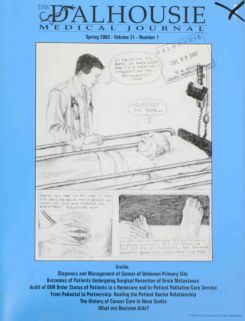Audit of Do-Not-Resuscitate Order Status of Patients in a Homecare and In-Patient Palliative Care Service
DOI:
https://doi.org/10.15273/dmj.Vol31No1.4291Abstract
Do-Not-Resuscitate (DNR) orders vary in prevalence among palliative care services. Some hospice programs require patients to have completed DNR forms prior to service admission. It was our intent to investigate the rates of DNR orders in a multi-tiered, multi-service palliative care program and to compare these rates with ideals and goals of staff. We performed an audit, blinded to patient caregiver, of charts for patients on homecare and in-patient services. We then constructed a questionnaire to investigate staff perceptions and goals for DNR status of patients in their care. After reviewing 87 charts, we determined the prevalence of DNR status to be 48%. From the completed questionnaires, staff estimated (mean [95% CI]) that 72% [58, 86] of patients under their care had DNR orders. Also, staff felt that 96% [90, 101] of patients under their care should have DNR orders in place. There was therefore discrepancy between the prevalence, perceived prevalence, and desired prevalence of DNR orders in this palliative care service. Following this investigation, the lead author chaired an open forum with staff to address these discrepancies. Staff felt a new method of tracking DNR status as well as a more structured timeline to address DNR status with patients on service is warranted. A follow-up study to evaluate improvements spawned from this audit would indeed be interesting.Downloads
How to Cite
Lightfoot, C. B., & McIntyre, P. F. (2003). Audit of Do-Not-Resuscitate Order Status of Patients in a Homecare and In-Patient Palliative Care Service. DALHOUSIE MEDICAL JOURNAL, 31(1). https://doi.org/10.15273/dmj.Vol31No1.4291
Issue
Section
Articles
License
Authors who publish with this journal agree to the following terms:
- Authors retain copyright and grant the journal right of first publication with the work simultaneously licensed under a Creative Commons Attribution License that allows others to share the work with an acknowledgement of the work's authorship and initial publication in this journal.
- Authors are able to enter into separate, additional contractual arrangements for the non-exclusive distribution of the journal's published version of the work (e.g., post it to an institutional repository or publish it in a book), with an acknowledgement of its initial publication in this journal.
- Authors are permitted and encouraged to post their work online (e.g., in institutional repositories or on their website) prior to and during the submission process, as it can lead to productive exchanges, as well as earlier and greater citation of published work (See The Effect of Open Access).


